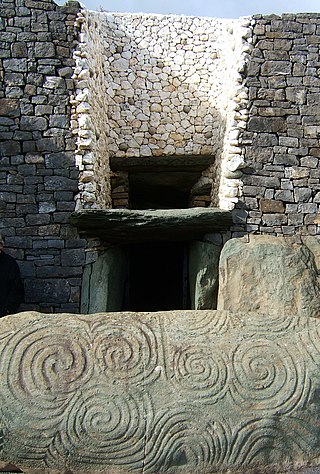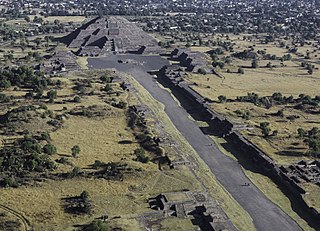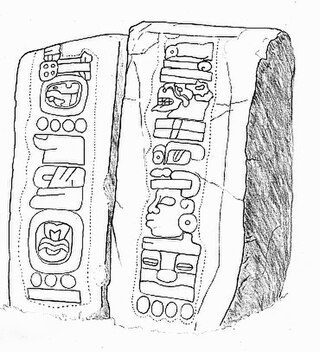Related Research Articles

Archaeoastronomy is the interdisciplinary or multidisciplinary study of how people in the past "have understood the phenomena in the sky, how they used these phenomena and what role the sky played in their cultures". Clive Ruggles argues it is misleading to consider archaeoastronomy to be the study of ancient astronomy, as modern astronomy is a scientific discipline, while archaeoastronomy considers symbolically rich cultural interpretations of phenomena in the sky by other cultures. It is often twinned with ethnoastronomy, the anthropological study of skywatching in contemporary societies. Archaeoastronomy is also closely associated with historical astronomy, the use of historical records of heavenly events to answer astronomical problems and the history of astronomy, which uses written records to evaluate past astronomical practice.

Teotihuacan is an ancient Mesoamerican city located in a sub-valley of the Valley of Mexico, which is located in the State of Mexico, 40 kilometers (25 mi) northeast of modern-day Mexico City.
The tzolkʼin is the 260-day Mesoamerican calendar used by the Maya civilization of pre-Columbian Mesoamerica.

The calendrical systems devised and used by the pre-Columbian cultures of Mesoamerica, primarily a 260-day year, were used in religious observances and social rituals, such as divination.

K’uk’ulkan, also spelled Kukulkan, is the serpent deity of Maya mythology. It is closely related to the deity Qʼuqʼumatz of the Kʼicheʼ people and to Quetzalcoatl of Aztec mythology. Prominent temples to Kukulkan are found at archaeological sites in the Yucatán Peninsula, such as Chichen Itza, Uxmal and Mayapan.
The Mayan architecture of the Maya civilization spans across several thousands of years, several eras of political change, and architectural innovation before the Spanish colonization of the Americas. Often, the buildings most dramatic and easily recognizable as creations of the Maya peoples are the step pyramids of the Terminal Preclassic Maya period and beyond. Based in general Mesoamerican architectural traditions, the Maya utilized geometric proportions and intricate carving to build everything from simple houses to ornate temples. This article focuses on the more well-known pre-classic and classic examples of Maya architecture. The temples like the ones at Palenque, Tikal, and Uxmal represent a zenith of Maya art and architecture. Through the observation of numerous elements and stylistic distinctions, remnants of Maya architecture have become an important key to understanding their religious beliefs and culture as a whole.

Rujm el-Hiri is an ancient stone, or megalithic, structure consisting of concentric circles of stone with a tumulus, a mound of earth and stone, at center. It is located in the Golan Heights some 16 kilometres (9.9 mi) east of the coast of the Sea of Galilee, in the middle of a large plateau covered with hundreds of dolmens, single chamber tombs of stone.

Mesoamerican architecture is the set of architectural traditions produced by pre-Columbian cultures and civilizations of Mesoamerica, traditions which are best known in the form of public, ceremonial and urban monumental buildings and structures. The distinctive features of Mesoamerican architecture encompass a number of different regional and historical styles, which however are significantly interrelated. These styles developed throughout the different phases of Mesoamerican history as a result of the intensive cultural exchange between the different cultures of the Mesoamerican culture area through thousands of years. Mesoamerican architecture is mostly noted for its pyramids, which are the largest such structures outside of Ancient Egypt.
David Humiston Kelley was an American archaeologist and epigrapher. He was associated with the University of Nebraska-Lincoln, and later with the University of Calgary. He is most noted for his work on the phonetic analysis and major contributions toward the decipherment of the writing system used by the Maya civilization of pre-Columbian Mesoamerica, the Maya script.

E-Groups are unique architectural complexes found among a number of ancient Maya settlements. They are central components to the settlement organization of Maya sites and, like many other civic and ceremonial buildings, could have served for astronomical observations. These sites have been discovered in the Maya Lowlands and other regions of Mesoamerica and have been dated to Middle Preclassical to Terminal Classic Period.
Floyd Glenn Lounsbury was an American linguist, anthropologist and Mayanist scholar and epigrapher, best known for his work on linguistic and cultural systems of a variety of North and South American languages. Equally important were his contributions to understanding the hieroglyphs, culture and history of the Maya civilization of pre-Columbian Mesoamerica.

In Mesoamerican mythology the Lords of the Night are a set of nine deities who each ruled over every ninth night forming a calendrical cycle. Each lord was associated with a particular fortune, bad or good, that was an omen for the night that they ruled over.

Galina Gavrilovna Yershova, or Ershova is a Russian academic historian, linguist, and epigrapher, who specialises in the study of the ancient civilisations, cultures, and languages of the New World. As an Americanist scholar, her area of expertise is in the field of Mesoamerican studies, and in particular that of the pre-Columbian Maya civilisation, its historical literature, and its writing system. Yershova is a former student and protégé of the Russian linguist and epigrapher Yuri Knorozov, renowned for his central contributions towards the decipherment of the Maya script.

The 2012 phenomenon was a range of eschatological beliefs that cataclysmic or transformative events would occur on or around 21 December 2012. This date was regarded as the end-date of a 5,126-year-long cycle in the Mesoamerican Long Count calendar, and festivities took place on 21 December 2012 to commemorate the event in the countries that were part of the Maya civilization, with main events at Chichén Itzá in Mexico and Tikal in Guatemala.
Clive L. N. Ruggles is a British astronomer, archaeologist and academic. He is the author of academic and popular works on the subject. In 1999, he was appointed professor of archaeoastronomy at the School of Archaeology and Ancient History, University of Leicester, when it is believed to have been the only appointed chair for archaeoastronomy among the world's universities. As of 2023, he was Emeritus Professor at this university.

El Caracol, the Observatory, is a unique structure at pre-Columbian Maya civilization site of Chichen Itza. El Caracol, which means 'snail' in Spanish, is so named due to the spiral staircase inside the tower.
Maya astronomy is the study of the Moon, planets, Milky Way, Sun, and astronomical phenomena by the Precolumbian Maya civilization of Mesoamerica. The Classic Maya in particular developed some of the most accurate pre-telescope astronomy in the world, aided by their fully developed writing system and their positional numeral system, both of which are fully indigenous to Mesoamerica. The Classic Maya understood many astronomical phenomena: for example, their estimate of the length of the synodic month was more accurate than Ptolemy's, and their calculation of the length of the tropical solar year was more accurate than that of the Spanish when the latter first arrived. Many temples from the Maya architecture have features oriented to celestial events.
Marilyn Masson is a Maya archaeologist whose research has focused on social transformation and political economy of ancient Mesoamerican cultures in Mexico and Belize. She is a professor of Mesoamerican archaeology at the University at Albany, SUNY. She is a co-director of the PEMY project at the site of Mayapan in the Northern Yucutan Peninsula of Mexico.
References
- 1 2 3 4 "Anthony (Tony) Aveni". Colgate University Directory. Retrieved 9 January 2025.
- 1 2 "Anthony Aveni Biography". Anthonyfaveni.com. Archived from the original on 2015-12-22. Retrieved 2015-12-19.
- 1 2 3 4 Nickels, Chris (October 7, 2004). "Aveni Awarded H.B. Nicholson Medal". The Colgate Maroon. Retrieved January 9, 2025.
- ↑ "2012 Symposium, Abstracts: The Measure and Meaning of Time in the Americas". Dumbarton Oaks. Retrieved January 9, 2025.
- ↑ "Author of The End of Time - The Maya Mystery of 2012". www.colgate.edu. Retrieved 2017-11-06.
- ↑ Gould, Stephen Jay; Atwan, Robert (2002). The Best American Essays 2002 . Houghton Mifflin Company. ISBN 9780618213887.
- ↑ Ridley, Matt; Lightman, Alan (2002-09-03). The Best American Science Writing 2002. Harper Collins. ISBN 9780060936501.
- ↑ "NSF Award Search: Award#8319854 - U.S.-Italy Cooperative Science: a Pilot Study of the Archaeoastronomy of Paleovenetic Ceremonial Sites". www.nsf.gov. Retrieved 2017-11-06.
- ↑ "About the SAA Awards". Society for American Archaeology. Retrieved January 9, 2025.